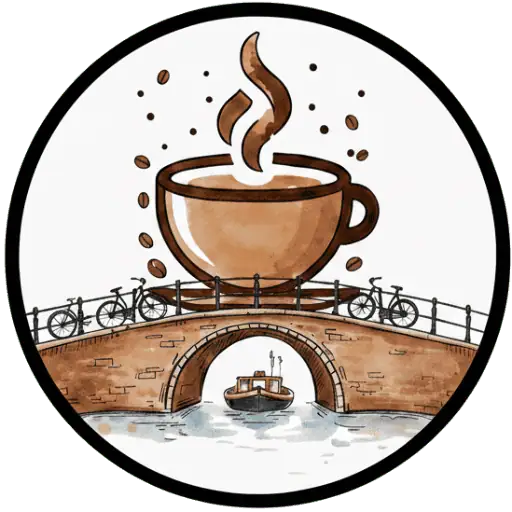High-Altitude Coffee
At high altitudes (above 1500 meters), coffee cherries ripen more slowly, resulting in denser beans with pronounced aromas. The lower temperature and thinner air foster a complex flavor profile, often characterized by high acidity and fruity, floral, or wine-like notes. Regions such as Ethiopia and parts of Latin America are known for their high-altitude coffees, which are prized for their refined and sparkling character.
High‑altitude coffee beans

Abakundakawa Rushashi – basic blend – Rwanda
Abakundakawa Rushashi van Ko Koffie komt uit het noorden van Rwanda. De gewassen Bourbon rijpt op hoogte en geeft perzik en nectarine. Het drievoudige fermentatieproces houdt de kop glashelder en sappig, met een nette, thee-achtige finish. Verwacht een middelmatige body, veel frisheid en een soepele doordrinkbaarheid. Deze branding werkt op filter en espresso, met focus…

Acatenango
Acatenango van Man met de Baard is een allround blend uit Brazilië en Peru. Verwacht chocolade, geroosterde noten en een frisse citruslift. De medium roast geeft body en helderheid. Arabica levert nuance, Robusta zorgt voor kracht en crema. Deze koffie werkt breed en vergeeft kleine zetfouten.Aan de slagEspresso startrecept 1:2 in 25-30 seconden.Filter 1:16 voor…

Alla Milanese
CoffeeXperts Alla Milanese is een toegankelijke espressoblend met romige body en heldere finish. De natural Braziliaanse component brengt chocoladezoetheid, terwijl gewassen Guatemala en Nicaragua zorgen voor schone lijnen en citrus. In espresso proef je melkchocolade en vanille, met gematigde aciditeit en zachte bitters. In melkdranken blijft het profiel stabiel en vol.Aanbevolen voor espressomachines en volautomaten,…

Altura, Mexico, Decaf
Altura Mexico Decaf komt van de biologisch gecertificeerde La Victoria Farm op 1750 meter hoogte, met een koel bergklimaat en veel neerslag. De bonen zijn Arabica Bourbon en Caturra en worden gewassen verwerkt. De cafeine wordt verwijderd via het waterproces Mountain Water, zonder chemicalien en met behoud van smaak. Het brandprofiel is semi tot medium,…

AMKA
AMKA is een licht gebrande Keniaanse koffie van Kamavindi Estate op 1700 meter. De anaerobe natural verwerking benadrukt uitgesproken fruit en complexiteit. Direct na branden proef je alcoholische rozijnen en framboos, na enkele dagen verschuift het aroma naar zoete kers. De hoge zuurgraad en levendige body maken deze koffie ideaal voor filter, maar verrassend geschikt…

Amkeni
Amkeni is een single origin koffie van de zuidelijke flank van de Kilimanjaro, in Mwika, Tanzania. De Bourbon variëteit is volledig gewassen met nachtfermentatie en gedroogd op verhoogde bedden. Verwacht aroma van tamarinde, sappige zoetheid als blauwe bes en een romige body die aan vanille doet denken. Dankzij samenwerking met This Side Up krijgen boeren…

Amkeni
Amkeni is een seizoenslot uit Tanzania, gebrand door Shokunin Coffee als lichte omniroast. Verwacht een schone kop met helderheid, sappige blauwe bes en romige vanille. De volledig gewassen Bourbon uit Mwika op de Kilimanjaro geeft een zijdezacht mondgevoel en een lange nasmaak. Voor espresso deelt de brander dit basisrecept dat deze boon laat spreken.20 g…

Amkeni, Tanzania
Amkeni is een gewassen Bourbon uit de Mwika gemeenschap aan de zuidwestflank van Kilimanjaro. De koffie wordt licht tot medium gebrand voor een zeer schone, fruitige kop met lichte body. Smaaknoten van blueberry, black tea en orange blossom geven helderheid en delicate zoetheid. Boeren werken met natuurlijke bemesting en gebruiken vee als brandstofbron. De centrale…

Andes
Sprout Coffee Roasters presenteert Andes, een espresso uit Cajamarca. Hoogte en vulkanische bodems geven een schone, zoete kop. Het washed proces legt cacao, karamel en zachte kruidigheid open. Het profiel blijft rond, met volle body en lange afdronk. Als espresso staat Andes stevig, puur en in cappuccino.Klassiek recept 19,5 g in, 43 g uit, 28…

Andrès Torres Geisha
Deze Geisha van Andres Torres komt van plantage Santa Teresa in Amazonas Peru op 1680 tot 1780 meter, omgeven door nevelwouden en watervallen. Keen Coffee brandt licht voor een heldere expressie van fruit en bloemen. Verwacht tonen van witte perzik, jasmijn, citrus en lychee met een elegante, zuivere afronding. De bessen worden natuurlijk verwerkt, soms…

Aracelly Estribi
Deze Geisha van Manhattan Coffee Roasters komt van perceel Estribi op Finca Santa Teresa in Santa Clara, Panama. De boon is washed verwerkt en schenkt een helder, elegant kopje met jasmijn, peer en pruim. De hoogte rond 1475 tot 1550 meter geeft levendige zuren en veel detail.Profiel, florale aroma’s met rijp steenfruit en lange, schone…

Argote
Argote Lactic Anaerobic van Stielman komt uit Génova in Nariño. De familie Argote werkt hoog in de Andes, op vulkanische bodems. Het proces is depulped anaerobic met zoutgestuurde fermentatie tot pH 3,6, acht dagen lang. Daardoor proeft de kop helder en gelaagd.Verwacht jasmijn, nootmuskaat en rijp fruit zoals papaja, banaan, aalbes en zwarte bes. De…

Argote
Argote Anaerobic Castillo van Shokunin komt uit Génova Nariño. Hoogte en vulkanische bodems geven helderheid. Anaerobe fermentatie brengt framboos, zwarte bes, vlierbloesem en nootmuskaat. De body is licht en theachtig met lange zoetheid. Ideaal voor liefhebbers van frisse, gelaagde koppen.Omni roast geschikt voor filter en espresso.Filter benadrukt floraal, espresso versterkt rood fruit en zoetheid.Kies voor…

Argote Anaerobic
Deze single origin komt uit Genova in Narino en wordt verbouwd door de Argote familie op 1950 tot 2000 meter. De loten ondergaan alcoholische anaerobe fermentatie en drogen op verhoogde droogbedden. Het brandprofiel is medium licht, geschikt voor filter en espresso, met fris aroma van nootmuskaat en hibiscus, sappige zoetheid van framboos en rode bes,…

Argote Juan Pablo Super Special
Argote Juan Pablo Super Special is een exclusieve microlot uit Nariño Colombia, geproduceerd door de familie Argote op grote hoogte. De koffie ondergaat een dubbel verlengde fermentatie, eerst lactische cherry, daarna ontpulpte alcoholische fermentatie, gevolgd door natuurlijke droging op verhoogde droogbedden. Het resultaat is een levendig profiel met limoenzeste en jasmijn, frambozenzoetheid en een romige…

Argote Juan Pablo Super Special
Shokunin presenteert Argote Juan Pablo Super Special, een beperkte microlot uit Génova, Nariño. De variëteiten Castillo en Caturra leveren helderheid en zoetheid. Een double extended ferment, eerst lactic cherry, daarna depulped alcoholic, geeft limoen, framboos en jasmijn. De branding is licht tot licht medium en bewaart de hoge aromatische intensiteit.Geschikt voor filter en espresso dankzij…
High Altitude (above 1500 meters)
Welcome to the world of high-altitude coffee! When you think of beans grown above 1500 meters, words like “refined,” “complex,” and “vibrant” often come to mind. But why exactly? In this article, we’ll dive into the effects of high altitudes on your espresso, the chemical composition of the beans, processing methods, and much more.
How altitude affects espresso flavor
At high altitudes, coffee cherries mature more slowly. This gradual ripening process allows sugars and acids in the fruit to develop over time, giving the beans ample opportunity to build a full range of flavors. When you use these beans for espresso, you’ll often taste a refined acidity and floral or fruity characteristics—think subtle citrus or berry aromas with a bright, almost “sparkling” quality. If you enjoy a delicate espresso, high-altitude beans are an excellent choice.
Chemical composition: density, sugars, and acids
Because the air is thinner and cooler at higher elevations, coffee trees receive less oxygen and grow at a slower pace. This results in denser beans that often exhibit higher acidity. The sugars develop more gradually, and the extended ripening contributes to a complex flavor structure. You end up with a bean that balances sweetness and complexity, translating into a lively cup of coffee. The increased density also impacts roasting profiles: roasters usually take extra care to highlight all those nuanced flavors.
Processing methods at high altitude
Thanks to the cooler, sometimes more humid climate, some coffee farmers opt for processing techniques that emphasize their beans’ unique characteristics. In many high-altitude regions, the washed method is especially popular, as it accentuates fruity and floral notes. Removing the pulp and mucilage under carefully controlled conditions allows any impurities to wash away, leaving a clean, pure flavor. There’s also some experimentation with natural and honey processes in these regions, though washed processing is often the standard for maintaining clarity.
Climate and microclimate
High-altitude environments have unique weather conditions: cooler nights, milder days, and often more rainfall. In some places, mist clings to the mountainsides, creating microclimates that can vary even from one slope to the next. This contributes to the slow ripening of cherries and the development of complex aromas. On the flip side, coffee farmers face challenges like fungal diseases in damp conditions, but the reward is a flavor profile cherished worldwide.
Yield and resilience
Growing coffee at 1500 meters or higher isn’t easy. The trees often produce fewer cherries because the plants expend more energy just to survive in cooler temperatures. Still, the beans command a premium for their pronounced quality and distinctive taste. Many farmers form cooperatives to share knowledge about cultivating coffee under these challenging conditions, employing innovative irrigation methods or using shade trees to protect their coffee plants.
Choosing coffee varieties
Not all coffee plants thrive at 2000 meters. Farmers often select varieties that can handle the cold and resist diseases, such as certain Arabica strains (like Bourbon, Typica, or Geisha). These varieties are known for their potential to develop subtle flavor nuances—a perfect match for the special circumstances high altitudes provide.
All in all, coffee from high altitudes isn’t just any cup of joe. Expect floral notes, a lively acidity, and refined aromas that will delight anyone seeking a bright and complex coffee experience.
